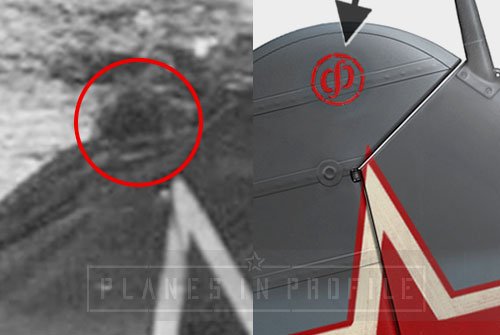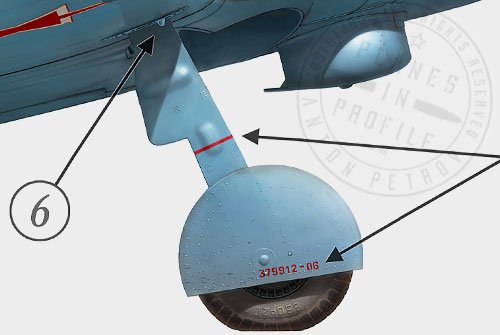Munkuev’s Gift
Lavochkin, La-5F (Type 37)
Airplane’s serial number (379912-06) ?
911th IAP, 29th IAD, 10th Air Army, Far East Front, (Possibly) Pereyaslavka airfield, Khabarovsk, Russia’s Far East, May 1944.
Flown by an unknown pilot (possibly by S.M.Laptiev)
In the cold months of early 1944 Purbo Munkuev and his family proudly posed for a photo with an inscribed La-5F fighter plane behind them (photo link is at the bottom of the page). This airplane was a gift to the Red Army built with the funds collected and donated by Munkuev and the workers of the collective farm which Munkuev was the chairman of, the farm called “Communism” in the Buryat-Mongolian Autonomous Republic. It is said that Stalin himself wrote a letter of gratitude to comrade Munkuev and the workers of this collective farm, thanking them for their monetary contribution to the Red Army fund.
This machine was one of the relatively few La-5s built at Factory number 99 in Ulan Ude, in the Buryatiya region of Russia. This factory began building La-5s in 1943, at a time when the La-5F modification had already been developed, therefore factory number 99 started its La-5 production run with the La-5F Type 37s. It built 184 La-5F [1] machines before switching to the La-5FNs in 1944.
After the gifting ceremony Munkuev’s airplane ended up in the 911th IAP which received their La-5s on the 13th of April 1944 [2]. This regiment was based in Russia’s Far East, at the Pereyaslavka airfield in Khabarovsk. In other words- in the Pacific theater of war. But the Red Army didn’t take much of a direct part in the fight against Japan until around the time Japan surrendered to the Allies in August 1945. Therefore, in April 1944 the 911th IAP was not engaged in any battle action as it was based in the rear, very far from the frontlines. During this time the regiment was most likely undergoing training on their new fighters. It was here in Khabarovsk, on the 25th of May 1944 ( just over one month after the 911th IAP received their La-5s) that Munkuev’s airplane nosed over on landing. Judging by the nasty crack through the middle of the plane’s fuselage in the photo, this machine was most likely written off after that.
Though the actual service history of this airplane is rather miserable and uninteresting, some of the airplane’s visual characteristics are quite special, as discussed below.
Noteworthy visual characteristics
General) The airplane was built in the second half of 1943, so it’s likely that there was at least some light weathering on it in May 1944 - the time period which I tried to base the art above on.
This machine is painted in a livery which is uncommon to the La-5F ,Type37s. While most planes of this type are usually painted with the Green/Black camo, Munkuev’s plane is painted in accordance with the Grey/Grey camouflage introduced in July 1943 and with the ‘late’ star insignia design introduced around September 1943. This helps to infer the time period when the airplane might have been built - likely in the autumn of 1943.
The stars, as always, appeared in the usual 6 positions, two on the fuselage, two on the tail, two on the underwings.
1) The exhaust panel in the photo reference appears to be the same colour as the rest of the plane (AMT-11 Blue-Grey), but in reality it was most likely unpainted metal, this was quite standard.
2) The inscription on the port side says:
This translates to:
To the Red Army
from the chairman of the collective farm
“Communism”
of the Buryat-Mongolian ASSR (Autonomous Soviet Socialist Republic)
comrade Munkuev P. M.
Please note that some of the inscription is obstructed in the photo reference, therefore the look and the content of the inscription in those areas is hypothetical in my artwork. It’s my best (educated) guess as to what the inscription in those parts might have looked like and what it said. The colour of the inscription is discussed further down the page.
3) the technical marking appear to be darker than the background paint, they were probably red.
4) Usually the la-5F airplanes have an ‘ Ф’ (F) symbol (representing the La-5F modification of the La-5) on the tip of the tail (Indicated by 4a) and on the engine cowling (Indicated by 4b). I believe there is a hint of the ‘F’ symbol visible there in the photo reference on the tip of the tail. It does look quite dark though, it’s possible that it was painted with red paint. If the symbol appeared on the tail then it probably also appeared on the engine cowling where it was usually painted in red over the top of a white circle.
5) The inscription on the starboard side says:
This translates to:
To the Red Army
from the collective farmers(male) of the collective farm
“Communism”
of the Selenginskiy
Aimak
of the Buryat-Mongolian ASSR (Autonomous Soviet Socialist Republic)
Please note that some of the inscription is obstructed in the photo reference, therefore the look and the content of the inscription in those areas is hypothetical in my artwork. It’s my best (educated) guess as to what the inscription in those parts might have looked like and what it said. The colour of the inscription is discussed further down the page.
6) The bomb rack attachment is exposed (the covers are absent)
7) Note the very unusual markings on the landing gear covers. It’s not clear what the red line is for, but the number which seems to be 379912-06 (if I have interpreted it correctly) is most likely the serial number of the airplane. 37 stands for the type of airplane (Type 37), 99 stands for the factory number (Factory number 99 in Ulan Ude), 12 is the series, and 06 is the number of the airplane in the production line.
8) Note the 'cover/sleeve’ on the suspension mechanism.
What colour was the inscription?
The short answer is - nobody seems to know:) But some options are discussed below.
Off-white ?
It is visible in the photo reference that the inscription was slightly darker than the white of the star, suggesting that the colour of the inscription was probably not white, or at least not the same white as the one used on the stars. It could have been some “off-white” colour, similar to the top image above.
Yellow?
Yellow was a hard-to-get colour in USSR during the war, perhaps partly due to the fact that ‘Yellow’ was often used by the Germans to identify their airplanes. Therefore the Soviets didn’t use it on their planes very often and because of that they didn’t have the need to produce/supply this colour for/to the air units. However, of course yellow did still exist in USSR during the war ( Yellow and Red are the most "communist" of colours after all - the colours of the Soviet Flag!) and it was still even used on Soviet airplanes, though in small quantities. Especially on airplanes which were distinguished with some ‘award’ markings or were inscribed with ‘gifting inscriptions’. Perhaps this made these select airplanes feel even more special since a ‘rare’ colour was used on them. For this reason it’s possible that the inscriptions on Munkuev’s plane were ‘yellow’ .
About the issue of confusing this plane with a ‘German’ airplane because of the presence of ‘yellow’ on it, well, that wasn’t an issue because this plane served at a different Front. It served in the Pacific theater of war.
Silver/Aluminium?
Unlike ‘Yellow’, ‘Silver’ paint was used often on Soviet planes, especially on some Polikarpovs just before the war which were sometimes entirely painted silver. It’s quite likely that there was still lots of this colour paint available to various air units/airfields. Silver would still make the inscription feel quite ‘special’ .
If we look at a close-up photo of parts of the inscription then it looks like the writing is quite dark in some areas (bottom of the photo) and quite light in others. This could suggest that the paint had a reflective quality similar to what one might expect from a ‘silver’ colour. But of course, maybe it was simply a ‘glossier’ paint (of any light colour) than the white used for the stars and therefore it simply reflected the light differently to the white of the star.
Based on the info above, there is a high chance that the inscription was ‘silver’. If it was then the airplane probably looked as per bottom illustration above.
Here are a few closeup images to help illustrate the points above. Full set of closeup images is On Patreon
FOOTNOTES
[1] The number of La-5Fs built at factory #99 is based on the book by Miloš Veštšik and Jiri Vrany called “Lavochkin La-5”, published by MBI in 2006, 1st edition. ISBN 80-86524-10-8 , page 39
[2] The date the regiment received their La-5s is based on: “All of Stalin’s Fighter Aviation Regiments” by Vladimir Anokhin and Mikhail Bykov, published by Yauza Press in 2014, ISBN 978-5-9955-0707-9 , page 887
LINKS TO THE REFERENCE IMAGES AND VIDEOS
A photo of Munkuev and his family in front of the airplane is in the top right of this book page:
https://books.google.com.au/books/content?id=4fD7kCJimQ0C&pg=PA199&img=1&zoom=3&hl=en&sig=ACfU3U1BpuzDrZ-IZPZgFt8vUGG6UWd_nA&w=1280
A photo of Munkuev’s airplane, crashed:
All the work presented on this is page is subject to updates and revisions in the light of new information which might present itself. If you have any new information relevant to this page or disagree with anything that's presented here, then please feel free to contact me through the Planes in Profile Facebook page. Thanks:)









